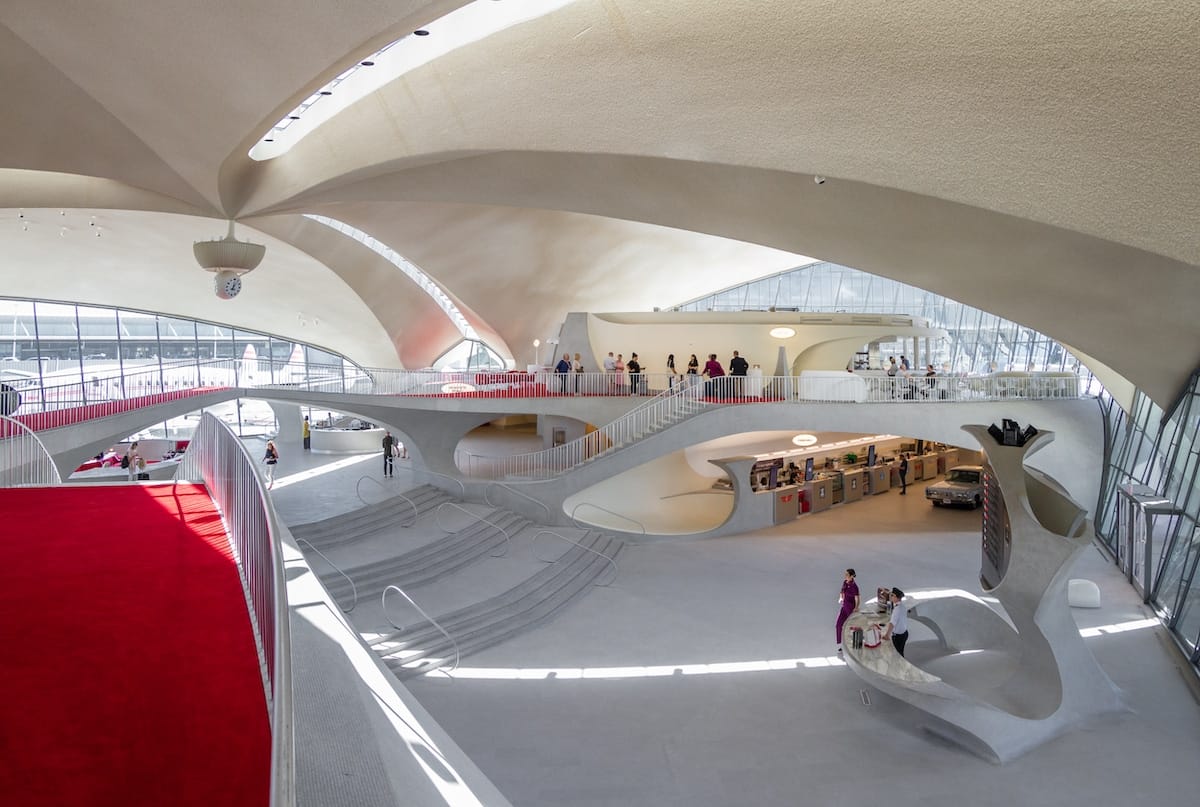Bloomfield Hills, Michigan, 1932. While the Great Depression paralyzes America and Streamline Moderne begins transforming the American industrial landscape, Finnish architect Eliel Saarinen founds an institution that will revolutionize American design: the Cranbrook Academy of Art. Far from the New York or California metropolises, in the affluent suburbs of Detroit, this school invents a unique pedagogical model, based on free experimentation, interdisciplinary collaboration, and artisanal excellence.
Unlike the German Bauhaus which privileges industrial production or Russian Constructivism which puts art at the service of revolution, Cranbrook cultivates a more organic and humanistic approach. Here, no dogmatic manifesto or standardized method. Charles and Ray Eames, Eero Saarinen, Florence Knoll, Harry Bertoia—an entire generation that would shape postwar American design—trains in this creative community where experimentation is privileged over theory, collaboration over hierarchy.
What is Cranbrook Academy
The Cranbrook Academy of Art, founded in 1932, defines itself less by a unified style than by a revolutionary pedagogical method. Eliel Saarinen, its founder, refuses the traditional academic model with its lectures and exams. He prefers to create a community of artist-residents where students and teachers live and work together, constantly exchange, freely collaborate.
This approach radically distinguishes Cranbrook from other design schools. Where Bauhaus imposes a standardized preliminary course and rigorous progression, Cranbrook lets each student develop their own path. Where Parisian Art Deco schools train in traditional crafts, Cranbrook encourages disciplinary hybridization. A sculptor can become interested in furniture, an architect in ceramics, a weaver in graphic design.
This pedagogical philosophy inscribes itself in the grand history of design as a unique moment. Cranbrook proves that excellent designers can be trained without theoretical dogmatism, that artisanal excellence and formal innovation are not opposed, that creative freedom can coexist with technical rigor. From 1932 to the 1970s, the school trains several generations that would dominate mid-century American design.
Historical & Cultural Context
Cranbrook Academy is born in a very specific American context. George Gough Booth, newspaper publisher and Detroit philanthropist, enriched by the automotive industry, decides in the 1920s to create an educational and cultural community on his Bloomfield Hills estate. He invites Finnish architect Eliel Saarinen (who is none other than Eero Saarinen‘s father), recently emigrated to the United States after winning second prize in the Chicago Tribune Tower competition (1922).
Saarinen first designs Cranbrook School (secondary school for boys), then Kingswood School (for girls), the Cranbrook Institute of Science, and finally the Academy of Art in 1932. The latter constitutes the project’s summit: a graduate school of art and design for adults, entirely financed by Booth, allowing total pedagogical freedom.
The context of the Great Depression paradoxically favors the project. Many talented artists and designers seek employment and stability. Cranbrook can recruit exceptional personalities as resident teachers: Swedish sculptor Carl Milles, Finnish textile designer Loja Saarinen (Eliel’s wife), Finnish ceramist Maija Grotell. These European masters bring refined artisanal tradition that blends with American experimental spirit.
Detroit’s nearby automotive industry provides a stimulating technical and economic context. New materials, production techniques, automotive ergonomic problems influence Cranbrook’s research. But unlike Streamline which puts itself at industry’s service, Cranbrook maintains a certain critical distance, privileging quality over quantity, craftsmanship over mass production.
The 1940s-50s, Cranbrook’s golden period, coincide with the United States’ emergence as a global superpower. The country needs to assert its cultural identity against Europe. Cranbrook contributes to creating a distinctive American design—neither a copy of European models nor simple commercial styling—but an original synthesis of technical excellence, formal innovation, and humanism.
Aesthetic Characteristics and Philosophy
Cranbrook aesthetic cannot be reduced to a unified style but to common principles. First, respect for materials and their honest expression. Unlike Streamline which masks structure under streamlining, Cranbrook design reveals the intrinsic beauty of wood, metal, fabric. This philosophy inherits from the Arts and Crafts movement but adapts it to the modern era.
Organicism and Natural Forms
A recurring characteristic in Cranbrook creations: organic forms inspired by nature. Curves are not aerodynamic and mechanistic as in Streamline, but biomorphic and sensual. Eero Saarinen’s chairs, Harry Bertoia’s sculptures, Marianne Strengell’s textiles: all evoke stylized natural forms.
This approach anticipates the organic design of the 1950s-60s but distinguishes itself through greater formal rigor. Cranbrook creations are not soft or random: they conjugate organic fluidity and rational structure. Eero Saarinen’s famous Tulip chair perfectly illustrates this synthesis: sculptural form inspired by a flower, but rigorous geometry and sophisticated technical construction.
Interdisciplinarity and Collaboration
Cranbrook systematically encourages interdisciplinary collaborations. Architects, sculptors, designers, weavers, ceramists work together on common projects. This approach, rare at the time, generates remarkable formal and technical innovations.
The most famous example: the collaboration between Charles Eames and Eero Saarinen on their molded plywood chair for MoMA’s “Organic Design in Home Furnishings” competition (1940). Neither could have created this technical and formal innovation alone. Their joint work, with the help of Ray Kaiser (future Ray Eames) and Harry Bertoia, literally invents modern molded plywood furniture.
Technical Excellence and Experimentation
Cranbrook cultivates a paradoxical approach: experimental freedom within a framework of artisanal excellence. The workshops—carpentry, metalwork, weaving, ceramics—are professionally equipped. Students learn traditional techniques before transgressing them. This technical mastery enables true innovation.
The famous molded plywood panels of the Eameses require years of experimentation in Cranbrook workshops. The casting process of Bertoia’s sculptures demands pointed metallurgical expertise. Marianne Strengell’s complex textiles require perfect weaving mastery. Innovation is born from mastered technique, not technical ignorance.
Creators & Key Figures
Eliel Saarinen (1873-1950)
Eliel Saarinen, Finnish architect, founds and directs Cranbrook until his death. His vision profoundly shapes the institution. Trained in the Finnish National Romantic tradition, he brings Nordic sensibility—respect for nature, artisanal excellence, arts integration—which he adapts to the American context.
His architecture for Cranbrook—brick buildings, stylized ornaments, landscaped gardens—creates an environment conducive to creation. But his essential contribution remains pedagogical: he invents a non-directive teaching model, based on exchange and emulation rather than top-down transmission. This approach, revolutionary at the time, durably influences American design education.
Eero Saarinen (1910-1961)
Eero Saarinen, Eliel’s son, literally grows up at Cranbrook. He studies there, teaches briefly there, develops his first creations there. His furniture—Tulip chair (1956), Womb chair (1948), Tulip table—perfectly translates Cranbrook aesthetic: organic forms, sophisticated technical construction, sculptural elegance.
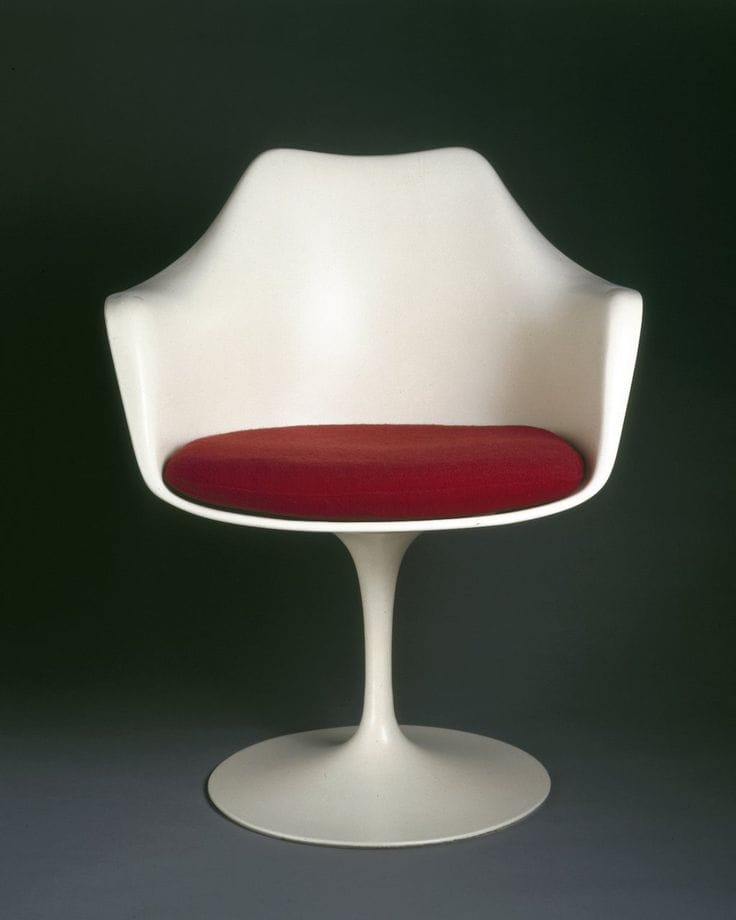
But Eero excels especially in architecture. His realizations—TWA Terminal at JFK Airport (1962), Gateway Arch in Saint Louis (1965), General Motors Technical Center (1956)—apply principles learned at Cranbrook to monumental scale: arts integration, expressive forms, structural innovation. He becomes one of the most influential American architects of the postwar period.
Charles and Ray Eames
Charles Eames (1907-1978) arrives at Cranbrook in 1938, fleeing a divorce and seeking a new start. There he meets Ray Kaiser (1912-1988), a young New York artist studying abstract painting. Their collaboration, first professional then matrimonial, becomes one of the most fertile in design history.
At Cranbrook, they experiment with molded plywood, win the MoMA competition in 1940, develop techniques that will lead to their famous chairs. But Cranbrook’s influence goes beyond furniture. The school’s interdisciplinary approach—design, architecture, photography, film—structures their entire career. Their California office perpetuates Cranbrook spirit: joyful experimentation, generous collaboration, technical excellence.
Florence Knoll (1917-2019)
Florence Schust, an orphan, finds at Cranbrook a family and a vocation. Protégée of Eliel Saarinen who becomes her guardian, she studies architecture, absorbs the philosophy of total design integration. She marries Hans Knoll and transforms the small family business into Knoll Associates, a major publisher of modern American furniture.
Florence Knoll doesn’t just publish furniture by other designers (Saarinen, Bertoia, Mies van der Rohe). She creates pieces herself—tables, desks, sofas—of rigorous sobriety. But above all, she invents the concept of spatial planning: conceiving work space as a coherent whole, where furniture, architecture, graphics integrate harmoniously. This holistic approach, inherited directly from Cranbrook, revolutionizes American corporate design.
Harry Bertoia (1915-1978)
Harry Bertoia, Italian immigrant to the United States, arrives at Cranbrook in 1937 to study and teach metalwork. There he develops a unique approach, at the frontier of sculpture and design. His jewelry, his sculptures, then his famous Diamond chairs (1952) demonstrate exceptional mastery of metal.
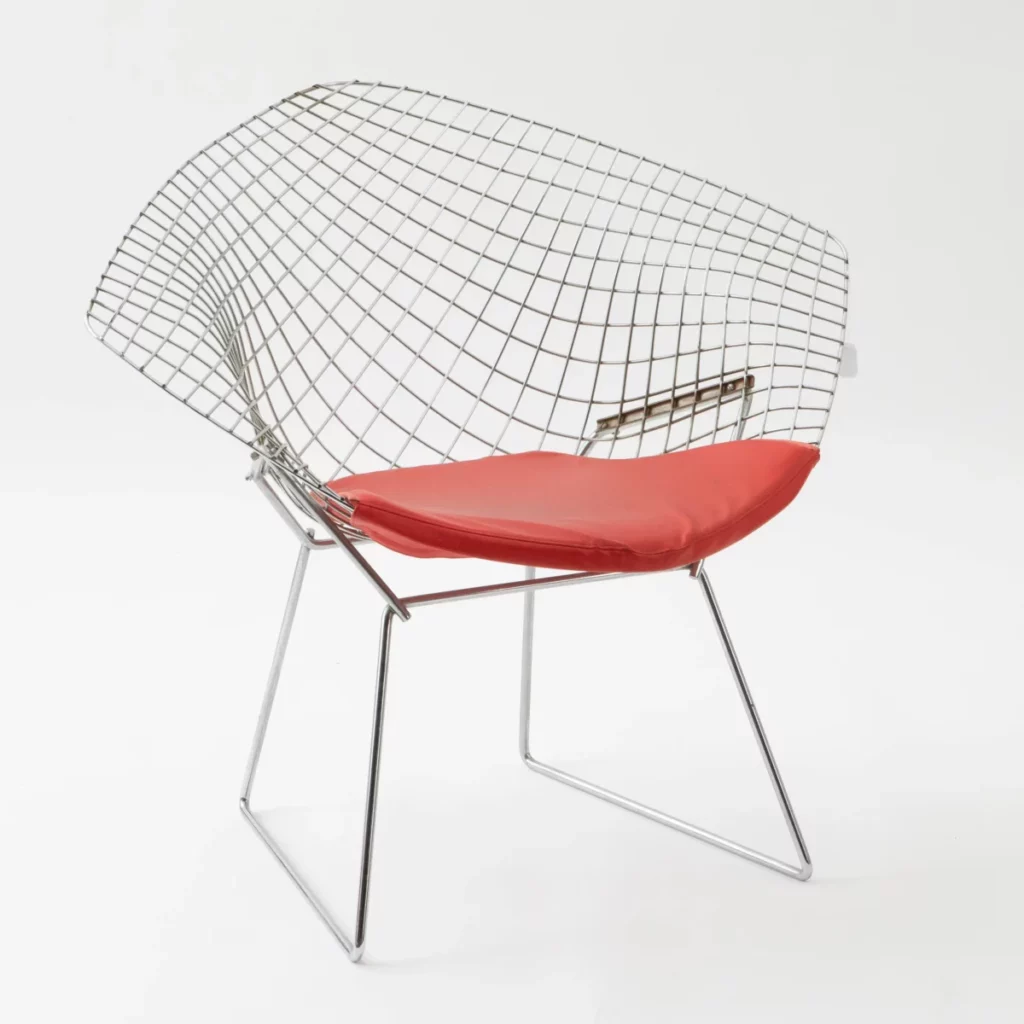
Bertoia perfectly embodies Cranbrook spirit: he refuses to separate art and design, sculpture and functionality. His chairs are not sculptures transformed into seats but objects that simultaneously assume their utilitarian and aesthetic dimension. This synthesis, difficult and rare, characterizes the best of Cranbrook design.
Marianne Strengell (1909-1998)
Marianne Strengell, Finnish, directs the textile department from 1937 to 1961. She transforms weaving, often considered minor feminine craft, into a domain of major research and innovation. Her textiles—curtains, tapestries, upholstery fabrics—conjugate Scandinavian tradition and American modernity.
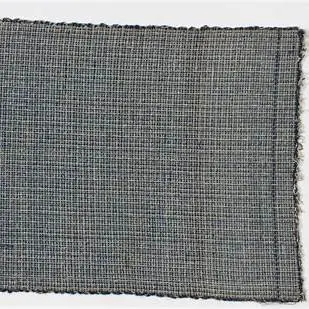
Strengell trains an entire generation of textile designers who will dominate the profession: Jack Lenor Larsen, Eszter Haraszty. She proves that excellence in so-called “minor” arts can equal that of “major” arts, anticipating later feminist claims about the hierarchy of artistic disciplines.
Emblematic Achievements
Molded Plywood Furniture
Cranbrook’s most spectacular innovation: three-dimensionally molded plywood. Charles and Eero, with Ray and Harry, experiment for years to create organic wood forms. Their chair for the 1940 MoMA competition—fluid curves, molded seat conforming to the body—revolutionizes furniture design.
The Eameses will pursue this research in California, resulting in the legendary LCW and DCW chairs (1946). Eero will develop his Womb chair (1948) then his Tulip chairs (1956). But all these creations are born from Cranbrook experimentations, from this workshop culture where one can try, fail, start again without immediate commercial pressure.
Bertoia’s Sculpture-Seats
Harry Bertoia’s Diamond and Wire chairs (1952) illustrate Cranbrook’s unique approach. They are neither functionalized sculptures nor decorated seats, but a perfect fusion of both. The welded steel wire structure creates a transparent volume, a sculpture of lines in space that happens to also be a comfortable seat.
This achievement requires exceptional technical mastery—precise welding, structural calculation, ergonomics—acquired in Cranbrook workshops. It embodies the school’s philosophy: formal innovation is born from technical excellence, beauty from deep understanding of materials.
Florence Knoll’s Corporate Spaces
Florence Knoll revolutionizes workspace planning in the 1950s-60s. Her projects for CBS, IBM, Rockefeller—structured open plans, sober and elegant furniture, art integration—create a new model of American office. This holistic approach, where the architect-designer controls all aspects of space, directly applies Eliel Saarinen’s philosophy learned at Cranbrook.
Eero Saarinen’s Architecture
Eero’s architectural realizations—TWA Terminal (JFK Airport, 1962), Gateway Arch (Saint Louis, 1965), MIT Chapel (Cambridge, 1955)—transport Cranbrook aesthetic to monumental scale. Sculptural forms, arts integration, structural innovation: all Cranbrook principles are found there amplified.
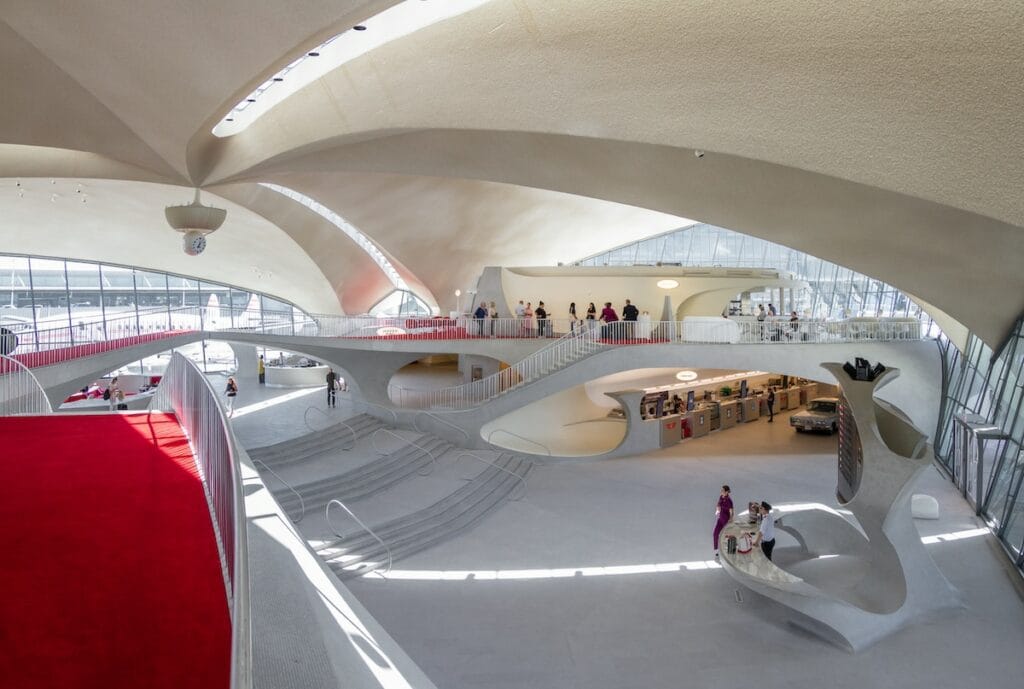
The TWA Terminal particularly embodies Cranbrook’s organic approach: its concrete shell roof evokes a bird in flight, its fluid structure abolishes right angles, its interior space creates a total experience. This expressive architecture, which refuses International Style dogmatism, asserts a distinct American modernity, direct heir to Cranbrook.
Influence and Legacy
Domination of Postwar American Design
In the 1950s-60s, Cranbrook alumni literally dominate American design. Eero Saarinen and the Eameses define modern furniture. Florence Knoll structures corporate spaces. Harry Bertoia creates emblematic sculptures and seats. Jack Lenor Larsen reigns over textiles. This concentration of talents trained in a single institution has no equivalent.
This domination is explained by training quality but also by the network created at Cranbrook. Alumni collaborate, recommend each other, help one another. Florence publishes Eero and Harry’s furniture. The Eameses exhibit their films in Saarinen’s buildings. This professional and friendly network, born from the Cranbrook community, structures American design for decades.
Pedagogical Influence
Cranbrook’s pedagogical model profoundly influences American design education. The idea of a creative community where teachers and students work together, the valorization of experimentation over theory, the encouragement of interdisciplinarity: these principles spread to many American schools.
Institutions like Pratt Institute, Rhode Island School of Design or Yale School of Art adopt elements of the Cranbrook model. This influence contrasts with that of Bauhaus, more theoretical and dogmatic. Cranbrook proves that pedagogical excellence can exist without rigid method, that structured creative freedom sometimes produces better results than standardization.
Continuity and Evolution
Cranbrook Academy continues to exist and train designers. After the golden period of the 1940s-60s, the school evolves but maintains its fundamental principles. The design, architecture, sculpture, textile, ceramics departments perpetuate the interdisciplinary approach. The preserved campus environment continues to offer a framework conducive to creation.
Contemporary designers among today’s great names like Katherine McCoy (who directs the graphic design department from 1971 to 1995) or Michael McCoy extend Cranbrook’s legacy by adapting it to the digital era. The New Wave and deconstructionist style in graphic design of the 1980s-90s largely emerges from Cranbrook.
Current Market and Collections
Cranbrook Furniture Value
Furniture created by Cranbrook alumni reaches dizzying heights in international sales. A first-edition Eames LCW chair can exceed 10,000 euros. An original Saarinen Womb chair approaches 5,000 euros. Bertoia’s sculpture-seats trade between 3,000 and 15,000 euros depending on models.
Reissues by Knoll, Herman Miller or Vitra remain more accessible while maintaining exceptional quality. A reissued Tulip chair costs approximately 1,500 euros, a Womb chair 3,000 euros, a Bertoia Diamond chair 800 euros. These prices testify to the lasting recognition of Cranbrook excellence.
Textiles by Marianne Strengell or Jack Lenor Larsen, rarer, interest collectors and museums. Original pieces from the 1940s-60s can reach several thousand euros, testimony to the revaluation of textile arts in design history.
Institutional Collections
The Cranbrook Art Museum, on the campus itself, preserves the most important collection of objects created at the school. Furniture, sculptures, ceramics, textiles: the museum traces the institution’s complete history. The archives—drawings, correspondence, photographs—document the creative process of masters and students.
MoMA in New York, the Art Institute of Chicago, LACMA in Los Angeles possess substantial collections of Cranbrook creations. These institutions recognize the school’s historical importance in the emergence of modern American design.
Conclusion
The Cranbrook Academy of Art embodies a unique approach in modern design history: neither the functionalist industrialism of Bauhaus, nor the political engagement of Constructivism, nor the commercial styling of Streamline. Cranbrook proposes a third way, typically American: artisanal excellence, free experimentation and creative humanism.
This approach radically distinguishes Cranbrook from European schools. Where Bauhaus imposes a standardized method, Cranbrook cultivates diversity of approaches. Where De Stijl seeks the universal in geometric abstraction, Cranbrook values individual expression in organic forms. Where Constructivism abolishes the distinction between art and production, Cranbrook maintains a fertile tension between the two.
The spectacular success of Cranbrook alumni—Eames, Saarinen, Knoll, Bertoia—proves the validity of this model. These creators dominate postwar American design, define what will be called Mid-Century Modern, create icons that traverse decades. Their common training at Cranbrook is not accidental: it’s there they learned to experiment without fear, to collaborate without hierarchy, to master techniques while transgressing them.
Cranbrook’s legacy remains ambivalent. On one hand, the school trained an extraordinarily talented elite that defined American design standards. On the other, this pedagogical model requires considerable resources—preserved campus, equipped workshops, favorable teacher/student ratio—difficult to reproduce elsewhere. Cranbrook perhaps represents a pedagogical ideal more than a generalizable model.
Contemporary institutions continue to draw inspiration from the Cranbrook approach. Interdisciplinarity, workshop culture, free experimentation remain valued pedagogical principles. But the context has changed: digital production often replaces artisanal work, commercial constraints impose themselves earlier, professional specialization leaves less room for exploration.
A century after its founding, Cranbrook fascinates by its creative humanism and its faith in experimentation. In a design world often dominated by commercial constraints and standardized methods, Cranbrook’s example reminds us that another approach is possible. Its message still resonates: excellence is born from freedom framed by technical mastery, innovation emerges from collaboration rather than competition, beauty results from deep understanding of materials and forms.
This capacity to unite artisanal rigor and experimental audacity, tradition and innovation, individuality and collaboration makes Cranbrook a unique moment in design history. Its legacy reminds us that design education is not reduced to transmitting methods or theories, that it’s also about creating an environment conducive to talent blossoming, a community where emulation stimulates creativity. Even if the Cranbrook model in its original form belongs to a bygone era, its requirement—training complete creators, technically excellent and formally audacious—remains an inspiration for all who believe in the transformative power of artistic education.

Digital entrepreneur and craft artisan, I use my unconventional background to share my vision of luxury design and interior decoration — one enriched by craftsmanship, history, and contemporary creation. Since 2012, I have been working daily in my workshop on the shores of Lake Annecy, creating bespoke interiors for discerning decorators and private clients.

